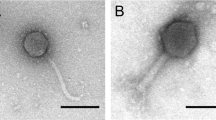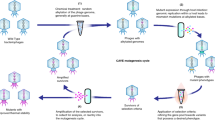Abstract
Expression of prodrug-activating enzymes that convert non-toxic substrates to cytotoxic derivatives is a promising strategy for cancer gene therapy. However, their catalytic activity with unnatural, prodrug substrates is often suboptimal. Efforts to improve these enzymes have been limited by the inability to select directly for increased prodrug activation. We have focussed on developing variants of Escherichia coli (E. coli) nitroreductase (NTR) with improved ability to activate the prodrug 5-(aziridin-1-yl)-2,4-dinitrobenzamide (CB1954), and describe here a novel, direct, positive selection for improved enzymes that exploits the alternative life cycles of bacteriophage lambda. In lambda lysogens of E. coli, the activation of the prodrug CB1954 by NTR triggers the SOS response to DNA damage, switching integrated lambda prophages into lytic cycle. This provides a direct, positive selection for phages encoding improved NTR variants, as, upon limiting exposure of lysogenized E. coli to CB1954, only those encoding the most active enzyme variants are triggered into lytic cycle, allowing their selective recovery. We exemplify the selection by isolating highly improved ‘turbo-NTR’ variants from a library of 6.8 × 105 clones, conferring up to 50-fold greater sensitivity to CB1954 than the wild type. Carcinoma cells infected with adenovirus expressing T41Q/N71S/F124T-NTR were sensitized to CB1954 concentrations 40- to 80-fold lower than required with WT-NTR.
This is a preview of subscription content, access via your institution
Access options
Subscribe to this journal
Receive 12 print issues and online access
$259.00 per year
only $21.58 per issue
Buy this article
- Purchase on Springer Link
- Instant access to full article PDF
Prices may be subject to local taxes which are calculated during checkout






Similar content being viewed by others
Abbreviations
- NTR:
-
nitroreductase
- CB1954:
-
5-(aziridin-1-yl)-2,4-dinitrobenzamide
References
McCalla DR, Kaiser C, Green MH . Genetics of nitrofurazone resistance in Escherichia coli. J Bacteriol 1978; 133: 10–16.
Anlezark GM, Melton RG, Sherwood RF, Coles B, Friedlos F, Knox RJ . The bioactivation of 5-(aziridin-1-yl)-2,4-dinitrobenzamide (CB 1954)—I. Purification and properties of a nitroreductase enzyme from Escherichia coli – a potential enzyme for antibody-directed enzyme prodrug therapy (ADEPT). Biochem Pharmacol 1992; 44: 2289–2295.
Bridgewater JA, Springer CJ, Knox RJ, Minton NP, Michael NP, Collins MK . Expression of the bacterial nitroreductase enzyme in mammalian cells renders them selectively sensitive to killing by the prodrug CB1954. Eur J Cancer 1995; 31A: 2362–2370.
Green NK, Youngs DJ, Neoptolemos JP, Friedlos F, Knox RJ, Springer CJ et al. Sensitization of colorectal and pancreatic cancer cell lines to the prodrug 5-(aziridin-1-yl)-2,4-dinitrobenzamide (CB1954) by retroviral transduction and expression of the E. coli nitroreductase gene. Cancer Gene Ther 1997; 4: 229–238.
McNeish IA, Green NK, Gilligan MG, Ford MJ, Mautner V, Young LS et al. Virus directed enzyme prodrug therapy for ovarian and pancreatic cancer using retrovirally delivered E. coli nitroreductase and CB1954. Gene Therapy 1998; 5: 1061–1069.
Grove JI, Searle PF, Weedon SJ, Green NK, McNeish IA, Kerr DJ . Virus directed enzyme prodrug therapy using CB1954. Anti-Cancer Drug Design 1999; 14: 461–472.
Weedon SJ, Green NK, McNeish IA, Gilligan MG, Mautner V, Wrighton CJ et al. Sensitisation of human carcinoma cells to the prodrug CB1954 by adenovirus vector-mediated expression of E. coli nitroreductase. Int J Cancer 2000; 86: 848–854.
Djeha AH, Hulme A, Dexter MT, Mountain A, Young LS, Searle PF et al. Expression of Escherichia coli B nitroreductase in established human tumor xenografts in mice results in potent antitumoral and bystander effects upon systemic administration of the prodrug CB1954. Cancer Gene Ther 2000; 7: 721–731.
Djeha AH, Thomson TA, Leung H, Searle PF, Young LS, Kerr DJ et al. Combined adenovirus-mediated nitroreductase gene delivery and CB1954 treatment: a well-tolerated therapy for established solid tumors. Mol Ther 2001; 3: 233–240.
Chung-Faye G, Palmer D, Anderson D, Clark J, Downes M, Baddeley J et al. Virus-directed, enzyme prodrug therapy with nitroimidazole reductase: a phase I and pharmacokinetic study of its prodrug, CB1954. Clin Cancer Res 2001; 7: 2662–2668.
Searle PF, Spiers I, Simpson J, James ND . Cancer gene therapy: from science to clinical trials. Drug Delivery Syst Sci 2002; 2: 5–13.
Palmer DH, Mautner V, Mirza D, Oliff S, Gerritsen W, Van Der Sijp JR et al. Virus-directed enzyme prodrug therapy: intratumoral administration of a replication-deficient adenovirus encoding nitroreductase to patients with resectable liver cancer. J Clin Oncol 2004; 22: 1546–1552.
Searle PF, Chen MJ, Hu L, Race PR, Lovering AL, Grove JI et al. Nitroreductase: a prodrug-activating enzyme for cancer gene therapy. Clin Exp Pharmacol Physiol 2004; 31: 811–816.
Grove JI, Lovering AL, Guise C, Race PR, Wrighton CJ, White SA et al. Generation of Escherichia coli nitroreductase mutants conferring improved cell sensitization to the prodrug CB1954. Cancer Res 2003; 63: 5532–5537.
Lovering AL, Hyde EI, Searle PF, White SA . The structure of Escherichia coli nitroreductase complexed with nicotinic acid: three crystal forms at 1.7 Å, 1.8 Å and 2.4 Å resolution. J Mol Biol 2001; 309: 203–213.
Black ME, Newcomb TG, Wilson HMP, Loeb LA . Creation of drug-specific herpes simplex virus type 1 thymidine kinase mutants for gene therapy. Proc Natl Acad Sci USA 1996; 93: 3525–3529.
Mahan SD, Ireton GC, Knoeber C, Stoddard BL, Black ME . Random mutagenesis and selection of Escherichia coli cytosine deaminase for cancer gene therapy. Protein Eng Des Sel 2004; 17: 625–633.
Sassanfar M, Roberts JW . Nature of the SOS-inducing signal in Escherichia coli. The involvement of DNA replication. J Mol Biol 1990; 212: 79–96.
Roberts JW, Devoret R . Lysogenic induction. In: Hendrix RW, Roberts JW, Stahl FW, Weisberg RA (eds). Lambda II. Cold Spring Harbor Laboratory Press: New York, 1983.
Hendrix RW, Roberts JW, Stahl FW, Weisberg RA (eds). Lambda II. Cold Spring Harbor Laboratory Press: New York, 1983.
Bridgewater JA, Knox RJ, Pitts JD, Collins MK, Springer CJ . The bystander effect of the nitroreductase/CB1954 enzyme/prodrug system is due to a cell-permeable metabolite. Hum Gene Ther 1997; 8: 709–717.
Race PR, Lovering AL, Green RM, Ossor A, White SA, Searle PF et al. Structural and Mechanistic Studies of Escherichia coli Nitroreductase with the Antibiotic Nitrofurazone: reversed binding orientations in different redox states of the enzyme. J Biol Chem 2005; 280: 13256–13264.
Elespuru RK, Gonda SK, Moore SG . Genetic and biochemical factors affecting the induction of bacteriophage lambda by N-nitroso compounds. IARC Sci Publ 1984: 731–739.
Sengupta S, Rahman MS, Mukherjee U, Basak J, Pal AK, Chatterjee SN . DNA damage and prophage induction and toxicity of nitrofurantoin in Escherichia coli and Vibrio cholerae cells. Mutat Res 1990; 244: 55–60.
Dale LD, Widdick DA, Edwards DI, Biol GI . Comparative DNA damage and repair induced by misonidazole, CB 1954 and RSU 1069. Int J Radiat Oncol Biol Phys 1989; 16: 995–999.
Stemmer WPC . DNA shuffling by random fragmentation and reassembly: in vitro recombination for molecular evolution. Proc Natl Acad Sci USA 1994; 91: 10747–10751.
Black ME, Kokoris MS, Sabo P . Herpes simplex virus-1 thymidine kinase mutants created by semi-random sequence mutagenesis improve prodrug-mediated tumor cell killing. Cancer Res 2001; 61: 3022–3026.
Kokoris MS, Black ME . Characterization of herpes simplex virus type 1 thymidine kinase mutants engineered for improved ganciclovir or acyclovir activity. Protein Sci 2002; 11: 2267–2272.
Mahan SD, Ireton GC, Stoddard BL, Black ME . Alanine-scanning mutagenesis reveals a cytosine deaminase mutant with altered substrate preference. Biochemistry 2004; 43: 8957–8964.
Christians FC, Scapozza L, Crameri A, Folkers G, Stemmer WP . Directed evolution of thymidine kinase for AZT phosphorylation using DNA family shuffling. Nat Biotechnol 1999; 17: 259–264.
Murray NE . Phage lambda and molecular cloning. In: Hendrix R (ed). Lambda II. Cold Spring Harbor Laboratory Press: New York, 1983, pp 395–431.
Sambrook J, Fritsch EF, Maniatis T . Molecular Cloning: A Laboratory Manual, 2nd edn. Cold Spring Harbor Laboratory Press: New York, 1989.
Acknowledgements
We acknowledge financial support from ML Laboratories plc and from the Medical Research Council (Grant number G9806623/44940).
Author information
Authors and Affiliations
Corresponding author
Additional information
Supplementary Information accompanies the paper on Gene Therapy website (http://www.nature.com/gt).
Supplementary information
Rights and permissions
About this article
Cite this article
Guise, C., Grove, J., Hyde, E. et al. Direct positive selection for improved nitroreductase variants using SOS triggering of bacteriophage lambda lytic cycle. Gene Ther 14, 690–698 (2007). https://doi.org/10.1038/sj.gt.3302919
Received:
Revised:
Accepted:
Published:
Issue Date:
DOI: https://doi.org/10.1038/sj.gt.3302919
Keywords
This article is cited by
-
NTR 2.0: a rationally engineered prodrug-converting enzyme with substantially enhanced efficacy for targeted cell ablation
Nature Methods (2022)
-
A mammalianized synthetic nitroreductase gene for high-level expression
BMC Cancer (2009)
-
E. coli NfsA: an alternative nitroreductase for prodrug activation gene therapy in combination with CB1954
British Journal of Cancer (2009)



